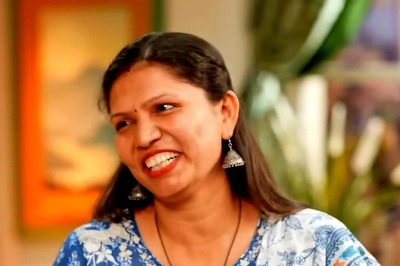
views
Poonam Pandey’s fake death stunt has divided social media users: some call it a brilliant move to raise cervical cancer awareness, others a tasteless hoax. As a policy executive and a public health student, I can’t help but admire her audacity.
She has made me recall the words of the Urdu poet Shefta: “If we become infamous, will we not have a name?” And she has certainly made a name for herself, as well as for HPV and cervical cancer. Now, everyone from Gen-Z to boomers is googling these terms, either out of curiosity or fear of missing out. Who knew a fake obituary could spark such a lively debate?
The curiosity is also very opportune and timely given our Finance Minister just pledged public provision of HPV vaccination to all the eligible girls in the country. Supply is being made available as demand is being generated in our country- the mark of a very responsive government!
Post-Poonam Pandey, people are asking a lot of questions. Let’s get answers. My source is WHO fact sheet of Cervical Cancer, GBD study, and direct experience with HIV and HPV as Project Director, Delhi State AIDS Control Society (DSACS).
What is cervical cancer?
It is a cancer of the birth canal in women (cervix), the lower part of the womb (uterus).
What causes cervical cancer?
Cervical cancer is caused by persistent infection with the Human Papillomavirus (HPV). There are many varieties of HPV virus, and some of them cause cancer, other cause diseases like genital warts.
Non-viral causes of cervical cancer are linked to an immunocompromised status like having HIV, and smoking.
How common is it?
20% of children who lose their moms to cancer do so due to cervical cancer. A woman dies of cervical cancer in the world every 90 seconds, and this rate will accelerate to one female dying of cervical cancer every minute this year if things stay as they are.
It is the second leading cause of cancer deaths among women in India, with 25 million women among 500 million-plus women in India harboring Human Papilloma Virus (HPV) 16/18 infection, the cause of 83.2 per cent of invasive cervical cancers.
Worldwide, Cervical cancer is the fourth most common cancer in women with an estimated 604 000 new cases and 342 000 deaths in 2020.
Maximum number of cervical cancer cases (>58%) are reported from Asia.
India carries higher burden, with incidence rate of 14.7 per 100,000 women compared to global rate of 13.1. 9.2 women per 100, 000 die of cervical cancer in India, compared to 6.9 globally. Translated, that is 124,000 women getting cervical cancer every year, and 78,000 dying from it at the same time – a very high mortality rate of 8 in 10 for a cancer.
What are non-health factors related to getting this cancer?
The highest rates of cervical cancer incidence and mortality are in low- and middle-income countries. Poor women, especially in rural areas, get more of it.
What makes us more prone and vulnerable to getting cervical cancer?
Poor genital hygiene, early age of marriage, repeated pregnancies, and smoking, make us more vulnerable. Women with HIV are 6 times more likely to get this cancer. Lack of screening and treatment facilities leads to more invasive forms of cancers and higher death rates.
How can we prevent it?
There is a trinity of interventions that help us prevent deadly forms of cervical cancer- HPV vaccination, Cervical Cancer Screening, and treatment of pre-cancerous and early cancerous lesions called CINs (Cervical Intraepithelial Neoplasia for the more curious readers).
This triad is also cost-effective. Screening and treatment are available mostly free at government health centers and hospitals. A free vaccine will be made available to eligible girls from this year in India. However, HPV vaccines are available through private clinics in India since last ten years.
The latest vaccines offer close to 100 per cent protection with a single shot.
Besides vaccination, screening for cervical cancer is also crucial to detect and treat precancerous lesions before they become invasive, reducing cervical cancer mortality by 50 per cent.
Also, recognizing symptoms and seeking medical advice to address any concerns is a critical step. Women should see a healthcare professional if they notice:
- unusual bleeding between periods, after menopause, or after sexual intercourse
- increased or foul-smelling vaginal discharge
- symptoms like persistent pain in the back, legs, or pelvis
- weight loss, fatigue and loss of appetite
- vaginal discomfort
- swelling in the legs.
Where do I get myself screened?
Screening is available at all health care facilities, starting with the health and wellness centers in villages in India.
Screening methods available are visual inspection with acetic acid or Lugol’s iodine (VIA/VILI), Papanicolaou test (Pap test or Pap smear) and HPV DNA (Deoxyribose Nucleic Acid) testing. VIA every 5 year is the most cost-effective screening method in the context of India.
VIA can be performed at the sub-centers, and health and wellness centers by ANMs.
Women should be screened for cervical cancer every 5–10 years starting at age 30. Women living with HIV should be screened every 3 years starting at age 25. The global strategy encourages a minimum of two lifetime screens with a high-performance HPV test by age 35 and again by age 45 years.
According to the National Family Health Survey 2021, only 1.97 per cent of women aged 30-49 had undergone cervical cancer screening in India, and 50 per cent of states had rates less than 1 per cent.
To increase screening and immunization coverage, we must talk more about cervical cancer, HPV, and prevention. Ask your ASHA Didi, ANM, or doctor for a screening test like VIA or PAP smear when you visit a health care Center for any type of care. It takes 5 minutes and is free.
If a lesion is detected, referrals to PHCs and district hospitals are made. These centers have treatment facilities for early cancers.
Do I need screening even after I am vaccinated?
Precancers rarely cause symptoms, which is why regular cervical cancer screening is important, even if you have been vaccinated against HPV.
What treatment is available for cervical cancer? Where is it available?
Cervical cancer can be cured if detected early and treated fast.
Treatment of precancers is a simple and painless procedure and prevents cervical cancer. Treatment may be offered in the same visit for screening at a district hospital.
If diagnosed, treatment services can include surgery, radiotherapy and chemotherapy as well as palliative care to provide supportive care and pain management. These are available at district hospitals and above in all parts of India.
Do men also get HPV related cancers?
HPV can infect skin, genital area and throat in men. HPV is thought to be responsible for more than 90 per cent of anal and cervical cancers, and more than 60 per cent of penile cancers. Oropharyngeal cancers may also be linked to HPV.
How may we prevent HPV in men?
Men are susceptible, too, and need HPV vaccine coverage for the prevention of HPV-related genital warts and carcinomas. Also, by getting vaccinated, men lower the chance of passing on the virus to their partners, who may develop cervical, vaginal, vulvar, or anal cancer from HPV.
Regular screening for HPV related lesions and cancers , especially for HIV positive men is available at all HIV/AIDS treatment facilities like ART centers.
Vaccines are currently being made available to adolescent girls only in the initial phase of Expanded Immunization Program in India. I am hopeful, once we cover the current and previous cohorts of girls eligible for vaccines, and the supply stabilizes to the numbers needed, we may start offering the vaccines to boys and men too.
Luckily, HPV vaccine are available in the market and through private physicians.
What is our government doing to help us prevent cervical cancer?
Cervical cancer is a preventable and treatable disease, yet it kills thousands of women in India every year. Our government is taking action to change this. We have developed Cervavax, a low-cost HPV vaccine that can protect against the virus that causes most cases of cervical cancer. We plan to offer this vaccine for free to millions of girls and women through our universal immunization program, starting from 2024.
We have also integrated cervical cancer screening with breast and oral cancer screening under the NPCDCS program, which aims to prevent and control major non-communicable diseases. These screenings are available at Health and Wellness centers across the country, and are covered by the Ayushman Bharat Scheme. Screenings are available at all other health care facilities starting from a sub-center, and can be performed by an ANM in 5 minutes. Our screening method is simple and effective: we use visual inspection with acetic acid, which has been proven to reduce cervical cancer deaths by 30%. Positive cases are referred to proper higher centers like a PHC or a district hospital where treatment for early cancers is available.
Sikkim is leading the way in this effort, having vaccinated 90% of its eligible girls with Cervavax. If Sikkim can, so can the rest of India. Ms. Pandey helped us surface the conversation on an important, deadly, and preventable disease. Together, we can eliminate cervical cancer by getting vaccinated, screened and treated early.
Dr Mrinalini Darswal, IAS, is currently a DrPH candidate at Harvard. A physician civil servant with post-graduate degrees in economics, artificial intelligence, and business analytics. She is also a cancer survivor. She can be reached at [email protected]. Views expressed in the above piece are personal and solely that of the author. They do not necessarily reflect News18’s views.


















Comments
0 comment